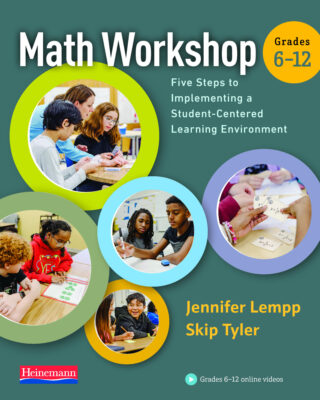
The current reality in education is that as teachers we have a lot to teach in a short period of time. It is not feasible to give up large chunks of math instruction in order to prepare students for math workshop. Rather, minilessons are designed to complement your math instruction.
When teachers commit themselves to teaching for understanding, classroom discourse and discussion are key elements in the overall picture. —Suzanne H. Chapin, Catherine O’Connor, Nancy Canavan Anderson, authors of Talk Moves, Third Edition (2013) |
Overview
In this lesson, students think about the importance of respectful communication in math and practice talking about their mathematical reasoning.
No longer is math class a place where students should be quietly working alone on a problem. While there may be times that you want your students to not talk so everyone can think to themselves, communication should be a normal part of a math lesson—and math workshop. Encourage students to discuss their thinking regularly with one another, either in pairs or with the whole class, throughout math class. Some students may be more comfortable taking this risk than others. It is important to discuss how to help everyone feel comfortable talking. Students need to know that each of their classmates have ideas and opinions; respecting everyone’s ideas is imperative, and being open-minded to others’ ideas will make everyone a better learner.
According to Number Talks author Sherry Parrish, “[There are] benefits of sharing and discussing computation strategies. Students have the opportunity to:
- clarify their own thinking
- consider and test other strategies to see if they are mathematically logical investigate and apply mathematical relationships
- build a repertoire of efficient strategies
- make decisions about choosing efficient strategies for specific problems” (2010/2014, 11).
Materials
- an open-ended math problem
- sentence frames and starters
Time
15 minutes
Directions
You are all knowledgeable students with wonderful ideas. It is important that we take the time to learn from one another. Some of us think best when we are able to process our thoughts out loud. Others do our best thinking when we have silent time first. There are times that I will encourage you to talk, and times that I will encourage you to think silently first. When we talk, it will be as a whole class, in small groups, or with a partner. Some of you may be more comfortable taking this risk than others. It is important that we discuss how to help everyone with this. We need to value everyone’s thoughts and opinions. We need to be respectful of everyone’s ideas; being open-minded to others’ ideas will actually make us better learners.
Let’s practice! At your table, you have a problem to solve. First, solve this problem independently and then allow each member of your group to talk, sharing how they solved it the way they did. Help each member of your group by encouraging them to discuss their strategies in detail and reminding them to be respectful of different answers or methods. Use the sentence frames posted to help you as you discuss this problem.
As students work together, it will be important to use talk moves to help them understand how to discuss this problem with one another. Consider asking questions that would help shape the conversations such as the following:
• Can you explain _____’s strategy?
• Can you add on to what _____ said?
• Do you agree or disagree with _____’s answer?
It’s important to remember that it takes a lot of practice for students to feel comfortable sharing and discussing their strategies. This is the start of an important process that will continue on a daily basis.
SUGGESTED PROBLEMS
• How many ways can you roll two 6-sided dice and get a sum of 7? What are the odds of rolling a sum of 7 with two 6-sided dice?
• Write three other expressions that are equivalent to the expression 4 − 2(x + 3).
• A number is between ¼ and ½. What might that number be? Consider as many possibilities as you can.
SUGGESTED SENTENCE FRAMES AND STARTERS
You might consider making sentence frames designed specifically for the problem that is being solved. For example, you might have a sentence frame for the problem listed above that looks like this: “My strategy for finding out the odds of rolling a sum of 7 is _____.” You could also make sentence frames and starters that are more generic such as the following:
• I agree with _____’s strategy.
• I thought about it a different way . . .
• I disagree with _____ because _____.



